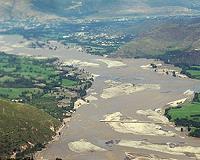| . |  |
. |
Wellington (AFP) Sept 8, 2010 The earthquake that devastated Christchurch may help, rather than hinder, economic growth by triggering a construction spree as New Zealand tries to shake off the effects of recession, analysts say. While no one died in Saturday's 7.0-magnitude quake, economic activity in the city has ground to a halt as authorities enforce a no-go zone in parts considered unsafe to enter due to danger from falling debris. The quake damaged an estimated 100,000 homes, tore up roads and smashed infrastructure such as water and sewage pipes, creating a repair bill officials estimate will reach four billion New Zealand dollars (2.7 billion US). Yet the benchmark NZX-50 share index rose steadily when trading resumed after the disaster, lifting more than two percent on Monday and Tuesday. Construction firms such as Fletcher Building and steel products manufacturer Steel & Tube were the biggest gainers as investors looked to an increase in building activity as the clean-up gathers pace. "The local economy is likely to get a substantial boost from reconstruction activity that will be much larger than the initial income loss," Westpac economists said in a briefing note. Analysts said billions of dollars being pumped into earthquake repairs could lift the economy as it slowly recovers from a recession that began in early 2008 and extended into the second quarter of 2009 "In many ways it couldn't have come at a better time, although that's an awful way to describe it," BNZ senior economist Craig Egbert said. Egbert said retailers could also benefit as homeowners and wholesalers replenished damaged goods, although he warned the disaster's scale made economic modelling difficult. But Nick Tuffley, an economist at ASB Bank, said there were international precedents for cataclysmic natural events lifting economic activity. "Overseas experiences suggest national GDP (gross domestic product) could be weak in the third quarter. However, reconstruction activity will subsequently boost GDP, potentially by 1.5 percentage points," Tuffley said. Westpac said natural disaster were most dangerous to an economy when it was performing strongly. "When the economy is running below capacity -- as is the case today, and especially in the construction sector -- the temporary boost to demand can be a substantial boost to GDP," the bank said. It pointed out that New Zealand's most destructive earthquake, at Napier in 1931 and which killed 256 people, occurred during the Great Depression and helped spur growth. Economists agreed that the Reserve Bank of New Zealand was set to keep interest rates on hold at 3.0 percent as it assesses the quake's impact. "The RBNZ will seek to shore up confidence in the first instance, so any remaining chance of a rate hike in the September monetary policy statement has been eliminated," Westpac said. Egbert said there was still uncertainty about the quake's effect, particularly since the government was about to introduce changes to its existing consumption tax and one of the country's biggest non-bank lenders, South Canterbury Finance, went into receivership this month. "The data was always going to be volatile, this just adds a whole layer of uncertainty to that," he said.
Share This Article With Planet Earth
Related Links Bringing Order To A World Of Disasters A world of storm and tempest When the Earth Quakes
 Saving flood-hit Pakistan has global implications: UNDP
Saving flood-hit Pakistan has global implications: UNDPNowshera, Pakistan (AFP) Sept 7, 2010 The world must help Pakistan rebuild homes and livelihoods destroyed by devastating floods to secure hearts and minds in the militant-hit nation, the UNDP's regional head told AFP. Global cash pledges have been slow in coming to bolster rescue and relief efforts ongoing in the flood-damaged nuclear nation, where more than 21 million people have been affected by a month of monsoon-triggered f ... read more |
|
| The content herein, unless otherwise known to be public domain, are Copyright 1995-2010 - SpaceDaily. AFP and UPI Wire Stories are copyright Agence France-Presse and United Press International. ESA Portal Reports are copyright European Space Agency. All NASA sourced material is public domain. Additional copyrights may apply in whole or part to other bona fide parties. Advertising does not imply endorsement,agreement or approval of any opinions, statements or information provided by SpaceDaily on any Web page published or hosted by SpaceDaily. Privacy Statement |